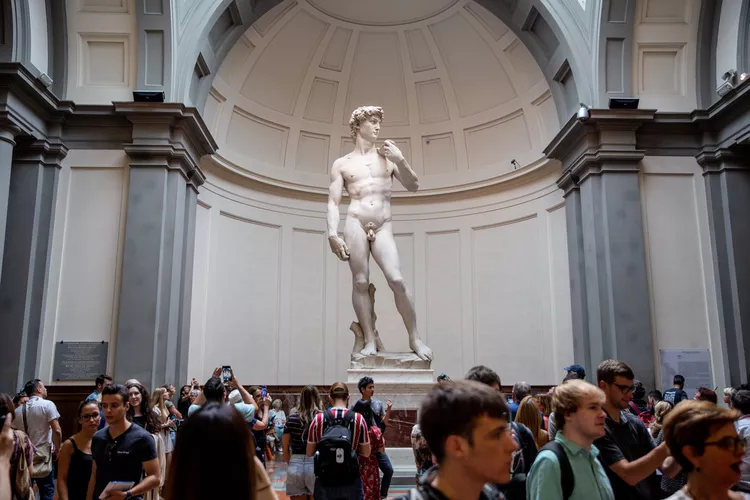The Galleria dell’Accademia, one of Florence’s top museums, is home to the world-famous statue of David by Michelangelo. The gallery is laid out on two floors, showcasing significant works by Michelangelo on the ground floor. Visitors to the Galleria dell’Accademia can anticipate an enriching experience filled with extraordinary art.
What to See on the Ground Floor
- Galleria dei Prigioni (Prisoners’ Gallery) — Here you will find Michelangelo’s Quattro Prigioni, which were originally sculpted for the tomb of Pope Julius II. The Prisoners are so called because they appear to be trying to free themselves from the marble in which they are carved. Michelangelo died before he was able to complete the works. Other notable pieces in this gallery include Michelangelo’s St. Matthew, which looks similarly “trapped” in marble, complemented by paintings from Michelangelo’s contemporaries, including Ghirlandaio and Andrea del Sarto.
- Tribuna del David — David’s Tribune is expansive, providing ample room for visitors to appreciate the approximately 17 feet (4 meters) tall statue from various angles. A particularly noteworthy aspect to observe is David’s right hand, which is veined and tense just before he slings his rock at Goliath. While there are about a dozen works from 16th-century artists such as Alessandro Allori and Bronzino, they are overshadowed by Michelangelo’s masterpiece.
- Sala del Colosso — A copy of Giambologna’s Rape of the Sabines, located in Loggia dei Lanzi near the Piazza della Signoria, stands at the center of this room. Surrounding it are dozens of paintings by 15th and 16th-century masters, including Filippino Lippi, Pietro Perugino, Lorenzo di Credi, Benozzo Gozzoli, Sandro Botticelli, and more.
- Sala di Giotto — This room highlights the influential 14th-century painter Giotto and his school, particularly Bernardo Daddi and Taddeo Gaddi, showcasing small religious paintings, including Daddi’s Crucifixion.
- Sala del Duecento e del Primo Trecento — Adjacent to the Sala di Giotto, this room contains some of the earliest paintings from Tuscany. The religious artworks date from between 1240 and 1340 and depict illuminated portraits of the Madonna and Saints, featuring a lovely L’Albero della Vita (Tree of Life) by Pacino di Buonaguida.
- Sala di Giovanni da Milano e degli Orcagna — In close proximity to the Giotto and Duecento/Trecento rooms, this gallery showcases altarpieces by Giovanni da Milano and the brothers di Cione, including Nardo di Cione and Andrea di Cione, also known as Andrea Orcagna.
- Salone dell’Ottocento — This room features paintings and sculptures from the 19th century, including a remarkable collection of plaster casts by Lorenzo Bartolini.
- Department of Musical Instruments — This compact gallery houses around 50 musical instruments from the private collections of the Tuscan Grand Dukes and the Medici, sourced from the Conservatorio Cherubini di Firenze, including a viola and a violin crafted by the legendary Stradivarius.
What to See on the Top Floor
- Sala del Tardo Trecento I and II — These two rooms on the top floor comprise several dozen altarpieces from the late 14th and early 15th centuries. Key highlights include a Pieta by Giovanni da Milano and an Annunciation by the Stonemasons and Carpenters Guild, which once adorned Orsanmichele.
- Sala di Lorenzo Monaco — This room displays approximately a dozen paintings by Lorenzo Monaco, a Camaldolese monk/artist, alongside works by Gherardo Starnina, Agnolo Gaddi, and others influenced by the International Gothic style.
- Sala del Gotico Internazional — The International Gothic style continues into the adjacent room, showcasing paintings by Giovanni Toscani, Bicci di Lorenzo, Maestro di Sant’Ivo, and others.





